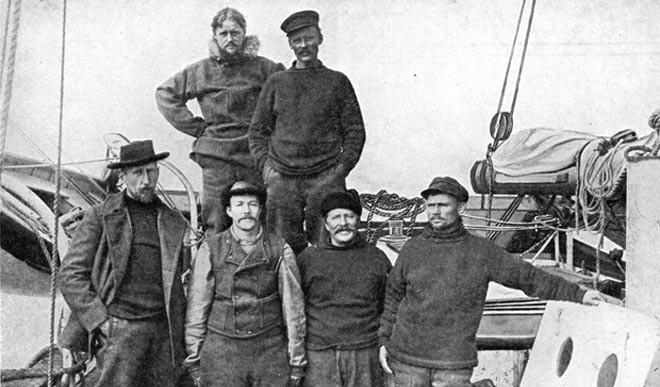Amundsen's North West Passage - not just a difficult sail
by Ned Rozell/Sail-World Cruising on 7 Apr 2012

Gjoa crew after arrival in Nome - FRONT ROW Amundsen, Peder Ristvedt, Adolf Lindstroem, Helmer Hansen - BACK ROW Godfred Hansen, Anton Lund SW
With the sea ice receding at a rapid rate more and more adventurous cruising sailors are heading for the North West Passage to take their chances. But at least they have GPS and Gore-tex.
First explorer Roald Amundsen's team did not only have to find a way without such technology or charts, they were sailing a 21 metre square-sterned, gaff-rigged sloop, which had once been a herring fishing boat.
They wore woolen clothes which were not water-proof and they were tough men. They were also pretty mean scientists. Science writer Ned Rozell explains.
More than a century ago, Roald Amundsen and his crew were the first to sail through the Northwest Passage, along the way leaving footprints in the Alaska towns of Eagle, Nome, and Sitka. Pioneering that storied route was a dream of Amundsen’s since his boyhood in Norway, but he also performed enduring science on the three-year voyage of the Gjøa.
Amundsen, from Norway, was 30 years old when, in the early 1900s, he envisioned and then executed this plan: 'With a small vessel and a few companions, to penetrate into the regions around earth’s north magnetic pole, and by a series of accurate observations, extending over a period of two years, to relocate the pole observed by Sir James Ross in 1831.'
The north magnetic dip pole is the expression of Earth’s magnetic field where a compass needle points straight downward. Though Amundsen didn’t know it at the time, this point is a moving target, wandering miles each day due to electrical currents in the upper atmosphere associated with the aurora and the solar wind.
If the sea ice allowed him, Amundsen told a crowd assembled in London, he planned on continuing west from northern Canada 'to sail through the Northwest Passage in its entire extent, this being a problem which for centuries has defied the most persistent efforts.'
Though the conquest of the Northwest Passage brought Amundsen worldwide fame, his devotion to science was real. Instead of blasting through the passage, he and his crew halted the Gjøa to spend the winter in a bay off King William Island in the Canadian Arctic.
There, they set up a base called 'Gjøahaven,' or Gjøa Harbor. They killed 100 reindeer for winter meat to feed man and dog, met the local natives, exchanged their wool clothes for furs and watched the ice form on the ocean in early October 1903. They also built a magnetic observatory out of shipping crates. They held it together with nails containing no iron. They covered the hut with tundra to keep out the light, because photographic paper recorded their magnetic observations.
Inside the building were four instruments sensitive to variations of Earth’s magnetic field. A few oil lamps heated and lit the observatory, which was so snug that Amundsen and crewman Gustav Wiik probably both suffered heart-muscle damage from carbon monoxide poisoning during the 19 months they faithfully tended the instruments.
But the adventurers’ scientific timing was good, as their station, located just 125 miles from the north magnetic dip pole recorded by Englishman John Ross 70 years earlier, captured with wriggling needles one of the largest magnetic storms in history on Halloween of 1903.
Wiik, who died on the journey before the rest of the crew reached Nome, was the man who spent most of the time in the hut with the magnetometers, checking on them day and night for more than a year and a half. And, says Charles Deehr, a space physicist and aurora forecaster at the University of Alaska Fairbanks’ Geophysical Institute, Wiik’s 360 magnetic measurements at Gjøahaven were top notch, despite 'almost impossible conditions.'
The data set is so good that Deehr, who posts forecasts of northern lights here at the Geophysical Institute, said the information is similar to data he gets today from satellites parked in the solar wind, a flow of the sun’s particles that excites the aurora into action.
Wiik and Amundsen’s measurements 'offer more than a glimpse of the character of the solar wind 50 years before it was known to exist,' Deehr said. And, 'Amundsen was the first to demonstrate, without doubt, that the north magnetic (pole) does not have a permanent location, but moves in a fairly regular manner.'
http://www2.gi.alaska.edu/Pipeline/ned_bio.html!Ned_Rozell is a science writer at the University of Alaska Fairbanks Geophysical Institute.
If you want to link to this article then please use this URL: www.sail-world.com/95770